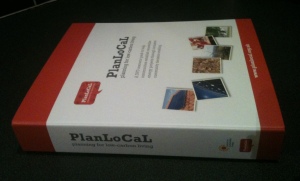I had been under the impression that district heating is only suitable for urban areas. Today I learned that district heating can also be economically feasible in rural areas, particularly those areas off the main gas network. This new knowledge is thanks to a Centre for Sustainable Energy event that I attended today. I went to understand more about how councillors and local planning authorities can support community-led energy projects. Among other things, I ended up learning how to assess whether a particular village has enough local woodland to support a biomass district heating scheme.

The purpose of the day was to give the audience tools to help communities develop their own renewable energy projects. In the afternoon exercise we put the CSE’s new PlanLoCaL resource pack into use. Each table had a different task. Our table was looking at the initial feasibility for district heating in a rural village with about 40 houses, a church, a primary school and a community centre. Using Ordnance Survey maps and pieces of string we located all of the woodland space in an 8km radius of the village. Then we used a plastic square with grids. Each square represented a hectare. This allowed us to count and catalogue:
- the type of woodland (coniferous, broadleaf, coppice, or a mix of these)
- the distance from the village
- the name of the woodland or nearby farm
- the approximate area of the woodland
We then used a very user-friendly spreadsheet that our facilitator, Rachel Coxcoon from CSE, had altered for this purpose from the Forestry Commission. We entered the types of buildings in the village and it automatically calculated the heat demand and required hectares of particular types of woodland. It became clear that several of the woodlands around the village could provide enough fuel for a biomass boiler to heat the village. The spreadsheet will be available on the PlanLoCaL website shortly.
This initial exercise was incredibly simple and fun. Anyone could do it. There’s no need to hire in expensive consultants for this one. The next step would be to contact the woodland owner and discuss the possibility of a supply contract for the village. The pack is full of similar exercises to help communities get started with hydro, solar power, energy from waste, wind and heat pumps.
Going back to the biomass district heating example, it’s clear that the pipes to hook up homes and buildings to the network aren’t free. But when compared to heating with oil or LPG (liquefied petroleum gas), this is an economical solution in some areas. And when the renewable heat incentive comes online this summer it may be even better. There is grant funding available to community groups for projects like these. Prudential borrowing and community investment schemes are also options. In reality it will probably be a mixture of all of the above.

The free resource pack explains all of the issues that a community would need to explore. If you work with communities or want to develop renewable energy in your own area it’s worth requesting a copy. It has DVDs with introductory information to communicate renewable energy to community groups. Equally valuable are the filmed case studies showing other community energy projects. In case you’re wondering, I don’t gain anything by promoting this resource. It’s just really damn good.
